Australian Economic History Review
VerifiedAdded on 2020/02/18
|19
|3601
|449
AI Summary
This assignment presents a collection of articles from reputable sources like the *Australian Economic Papers* and *The World Economy*, focusing on diverse topics within Australian economic history. Papers delve into themes such as business development, resource management (water scarcity), institutional structures, and macroeconomic imbalances. The selection also includes studies analyzing inflation, trade balance impacts, and the relationship between financial systems and economic growth in Australia.
Contribute Materials
Your contribution can guide someone’s learning journey. Share your
documents today.
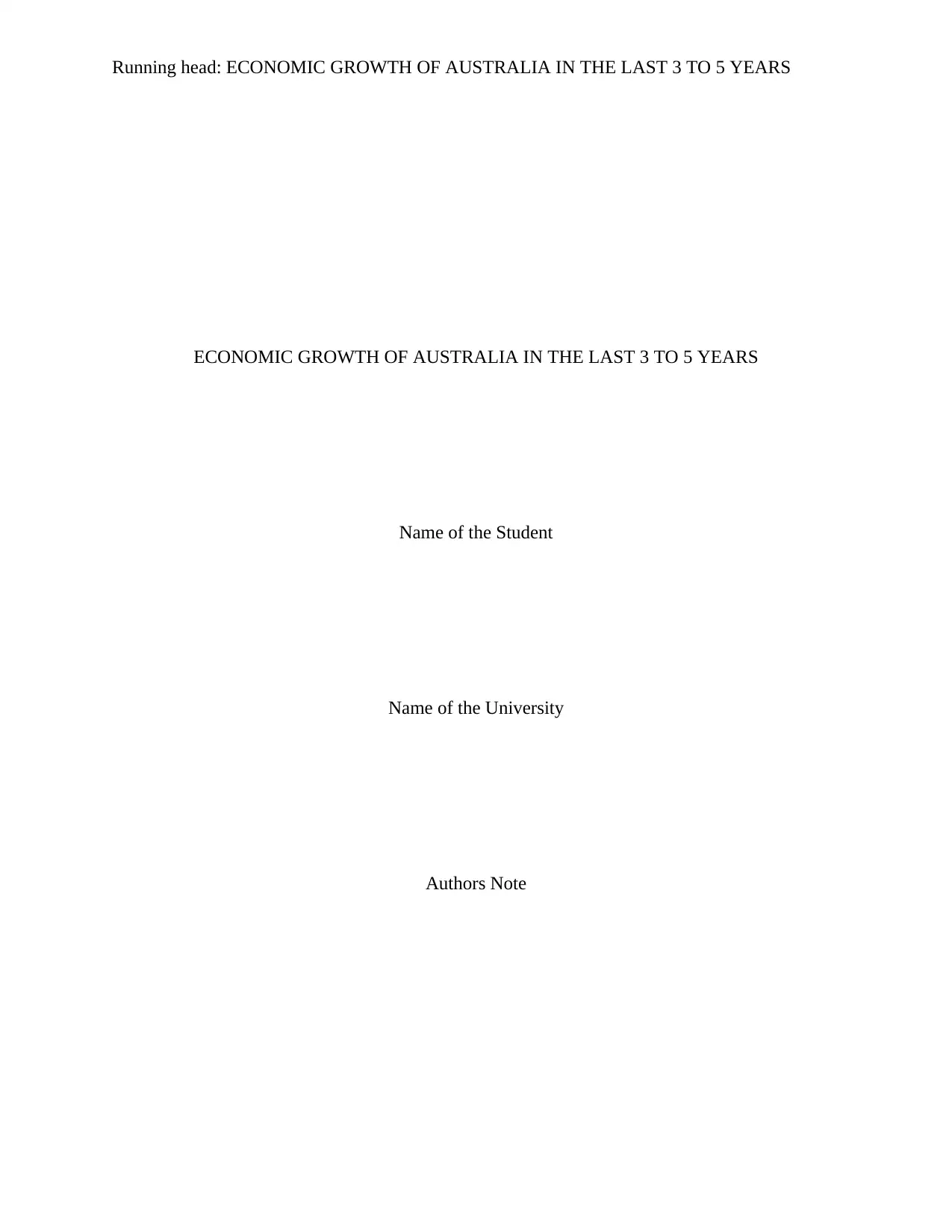
Running head: ECONOMIC GROWTH OF AUSTRALIA IN THE LAST 3 TO 5 YEARS
ECONOMIC GROWTH OF AUSTRALIA IN THE LAST 3 TO 5 YEARS
Name of the Student
Name of the University
Authors Note
ECONOMIC GROWTH OF AUSTRALIA IN THE LAST 3 TO 5 YEARS
Name of the Student
Name of the University
Authors Note
Secure Best Marks with AI Grader
Need help grading? Try our AI Grader for instant feedback on your assignments.
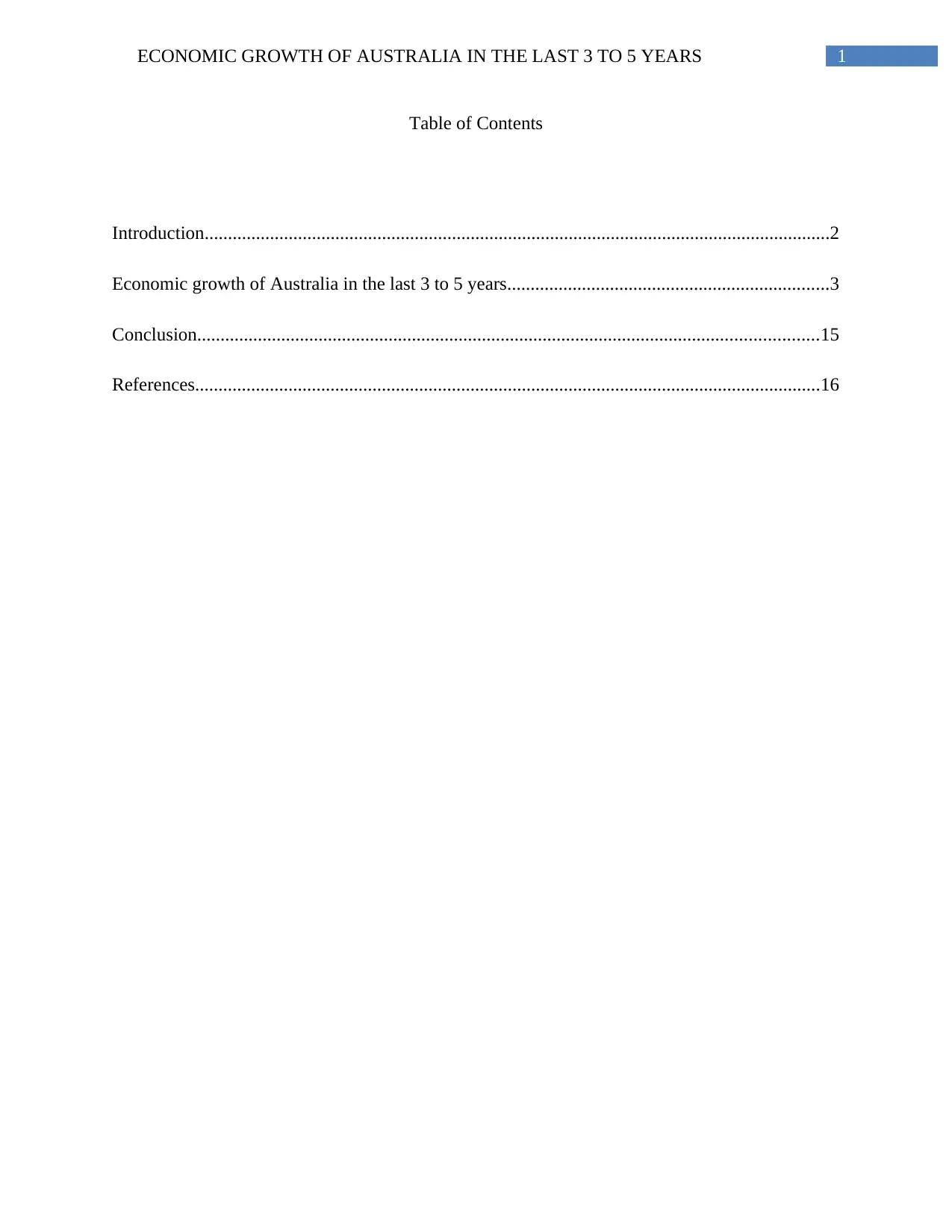
1ECONOMIC GROWTH OF AUSTRALIA IN THE LAST 3 TO 5 YEARS
Table of Contents
Introduction......................................................................................................................................2
Economic growth of Australia in the last 3 to 5 years.....................................................................3
Conclusion.....................................................................................................................................15
References......................................................................................................................................16
Table of Contents
Introduction......................................................................................................................................2
Economic growth of Australia in the last 3 to 5 years.....................................................................3
Conclusion.....................................................................................................................................15
References......................................................................................................................................16
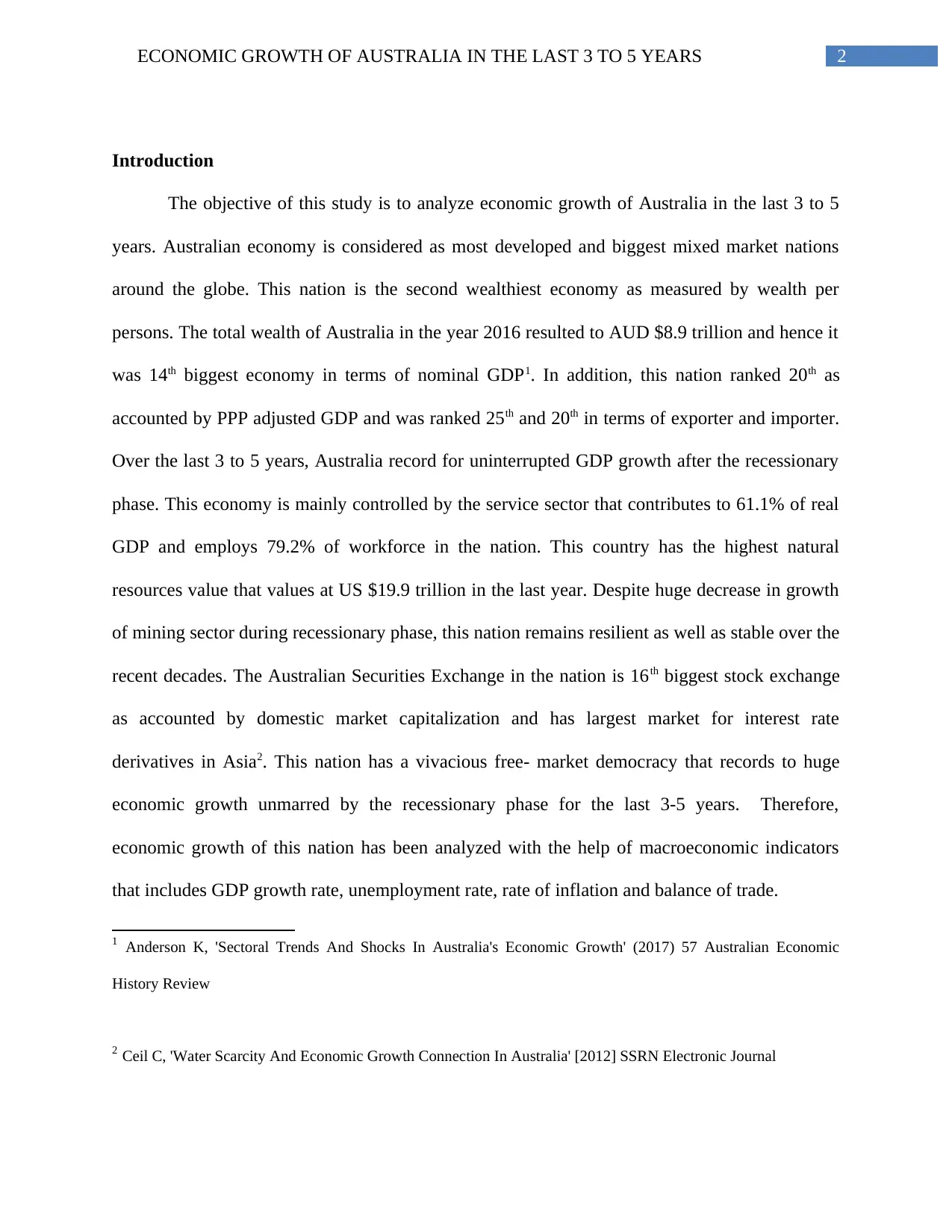
2ECONOMIC GROWTH OF AUSTRALIA IN THE LAST 3 TO 5 YEARS
Introduction
The objective of this study is to analyze economic growth of Australia in the last 3 to 5
years. Australian economy is considered as most developed and biggest mixed market nations
around the globe. This nation is the second wealthiest economy as measured by wealth per
persons. The total wealth of Australia in the year 2016 resulted to AUD $8.9 trillion and hence it
was 14th biggest economy in terms of nominal GDP1. In addition, this nation ranked 20th as
accounted by PPP adjusted GDP and was ranked 25th and 20th in terms of exporter and importer.
Over the last 3 to 5 years, Australia record for uninterrupted GDP growth after the recessionary
phase. This economy is mainly controlled by the service sector that contributes to 61.1% of real
GDP and employs 79.2% of workforce in the nation. This country has the highest natural
resources value that values at US $19.9 trillion in the last year. Despite huge decrease in growth
of mining sector during recessionary phase, this nation remains resilient as well as stable over the
recent decades. The Australian Securities Exchange in the nation is 16th biggest stock exchange
as accounted by domestic market capitalization and has largest market for interest rate
derivatives in Asia2. This nation has a vivacious free- market democracy that records to huge
economic growth unmarred by the recessionary phase for the last 3-5 years. Therefore,
economic growth of this nation has been analyzed with the help of macroeconomic indicators
that includes GDP growth rate, unemployment rate, rate of inflation and balance of trade.
1 Anderson K, 'Sectoral Trends And Shocks In Australia's Economic Growth' (2017) 57 Australian Economic
History Review
2 Ceil C, 'Water Scarcity And Economic Growth Connection In Australia' [2012] SSRN Electronic Journal
Introduction
The objective of this study is to analyze economic growth of Australia in the last 3 to 5
years. Australian economy is considered as most developed and biggest mixed market nations
around the globe. This nation is the second wealthiest economy as measured by wealth per
persons. The total wealth of Australia in the year 2016 resulted to AUD $8.9 trillion and hence it
was 14th biggest economy in terms of nominal GDP1. In addition, this nation ranked 20th as
accounted by PPP adjusted GDP and was ranked 25th and 20th in terms of exporter and importer.
Over the last 3 to 5 years, Australia record for uninterrupted GDP growth after the recessionary
phase. This economy is mainly controlled by the service sector that contributes to 61.1% of real
GDP and employs 79.2% of workforce in the nation. This country has the highest natural
resources value that values at US $19.9 trillion in the last year. Despite huge decrease in growth
of mining sector during recessionary phase, this nation remains resilient as well as stable over the
recent decades. The Australian Securities Exchange in the nation is 16th biggest stock exchange
as accounted by domestic market capitalization and has largest market for interest rate
derivatives in Asia2. This nation has a vivacious free- market democracy that records to huge
economic growth unmarred by the recessionary phase for the last 3-5 years. Therefore,
economic growth of this nation has been analyzed with the help of macroeconomic indicators
that includes GDP growth rate, unemployment rate, rate of inflation and balance of trade.
1 Anderson K, 'Sectoral Trends And Shocks In Australia's Economic Growth' (2017) 57 Australian Economic
History Review
2 Ceil C, 'Water Scarcity And Economic Growth Connection In Australia' [2012] SSRN Electronic Journal
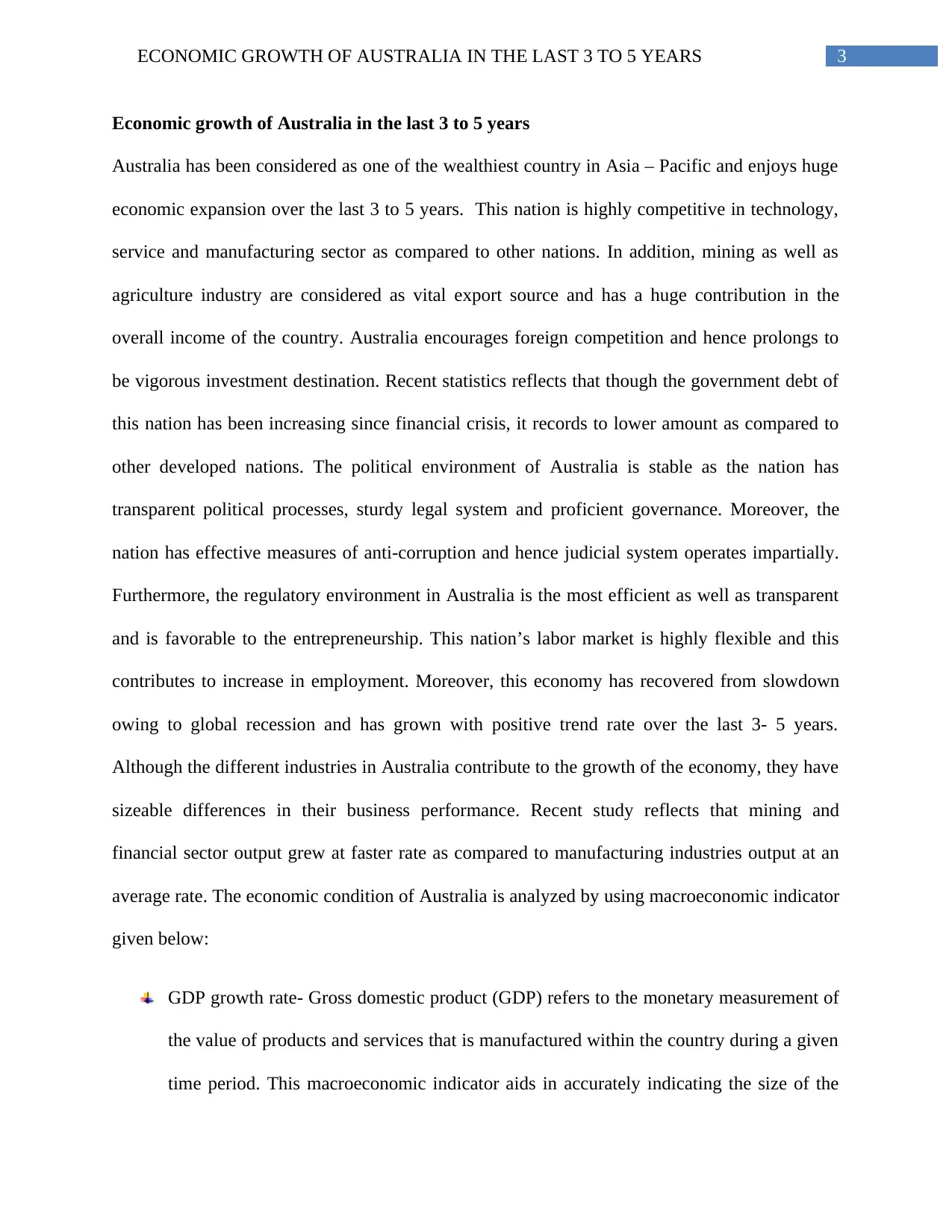
3ECONOMIC GROWTH OF AUSTRALIA IN THE LAST 3 TO 5 YEARS
Economic growth of Australia in the last 3 to 5 years
Australia has been considered as one of the wealthiest country in Asia – Pacific and enjoys huge
economic expansion over the last 3 to 5 years. This nation is highly competitive in technology,
service and manufacturing sector as compared to other nations. In addition, mining as well as
agriculture industry are considered as vital export source and has a huge contribution in the
overall income of the country. Australia encourages foreign competition and hence prolongs to
be vigorous investment destination. Recent statistics reflects that though the government debt of
this nation has been increasing since financial crisis, it records to lower amount as compared to
other developed nations. The political environment of Australia is stable as the nation has
transparent political processes, sturdy legal system and proficient governance. Moreover, the
nation has effective measures of anti-corruption and hence judicial system operates impartially.
Furthermore, the regulatory environment in Australia is the most efficient as well as transparent
and is favorable to the entrepreneurship. This nation’s labor market is highly flexible and this
contributes to increase in employment. Moreover, this economy has recovered from slowdown
owing to global recession and has grown with positive trend rate over the last 3- 5 years.
Although the different industries in Australia contribute to the growth of the economy, they have
sizeable differences in their business performance. Recent study reflects that mining and
financial sector output grew at faster rate as compared to manufacturing industries output at an
average rate. The economic condition of Australia is analyzed by using macroeconomic indicator
given below:
GDP growth rate- Gross domestic product (GDP) refers to the monetary measurement of
the value of products and services that is manufactured within the country during a given
time period. This macroeconomic indicator aids in accurately indicating the size of the
Economic growth of Australia in the last 3 to 5 years
Australia has been considered as one of the wealthiest country in Asia – Pacific and enjoys huge
economic expansion over the last 3 to 5 years. This nation is highly competitive in technology,
service and manufacturing sector as compared to other nations. In addition, mining as well as
agriculture industry are considered as vital export source and has a huge contribution in the
overall income of the country. Australia encourages foreign competition and hence prolongs to
be vigorous investment destination. Recent statistics reflects that though the government debt of
this nation has been increasing since financial crisis, it records to lower amount as compared to
other developed nations. The political environment of Australia is stable as the nation has
transparent political processes, sturdy legal system and proficient governance. Moreover, the
nation has effective measures of anti-corruption and hence judicial system operates impartially.
Furthermore, the regulatory environment in Australia is the most efficient as well as transparent
and is favorable to the entrepreneurship. This nation’s labor market is highly flexible and this
contributes to increase in employment. Moreover, this economy has recovered from slowdown
owing to global recession and has grown with positive trend rate over the last 3- 5 years.
Although the different industries in Australia contribute to the growth of the economy, they have
sizeable differences in their business performance. Recent study reflects that mining and
financial sector output grew at faster rate as compared to manufacturing industries output at an
average rate. The economic condition of Australia is analyzed by using macroeconomic indicator
given below:
GDP growth rate- Gross domestic product (GDP) refers to the monetary measurement of
the value of products and services that is manufactured within the country during a given
time period. This macroeconomic indicator aids in accurately indicating the size of the
Secure Best Marks with AI Grader
Need help grading? Try our AI Grader for instant feedback on your assignments.
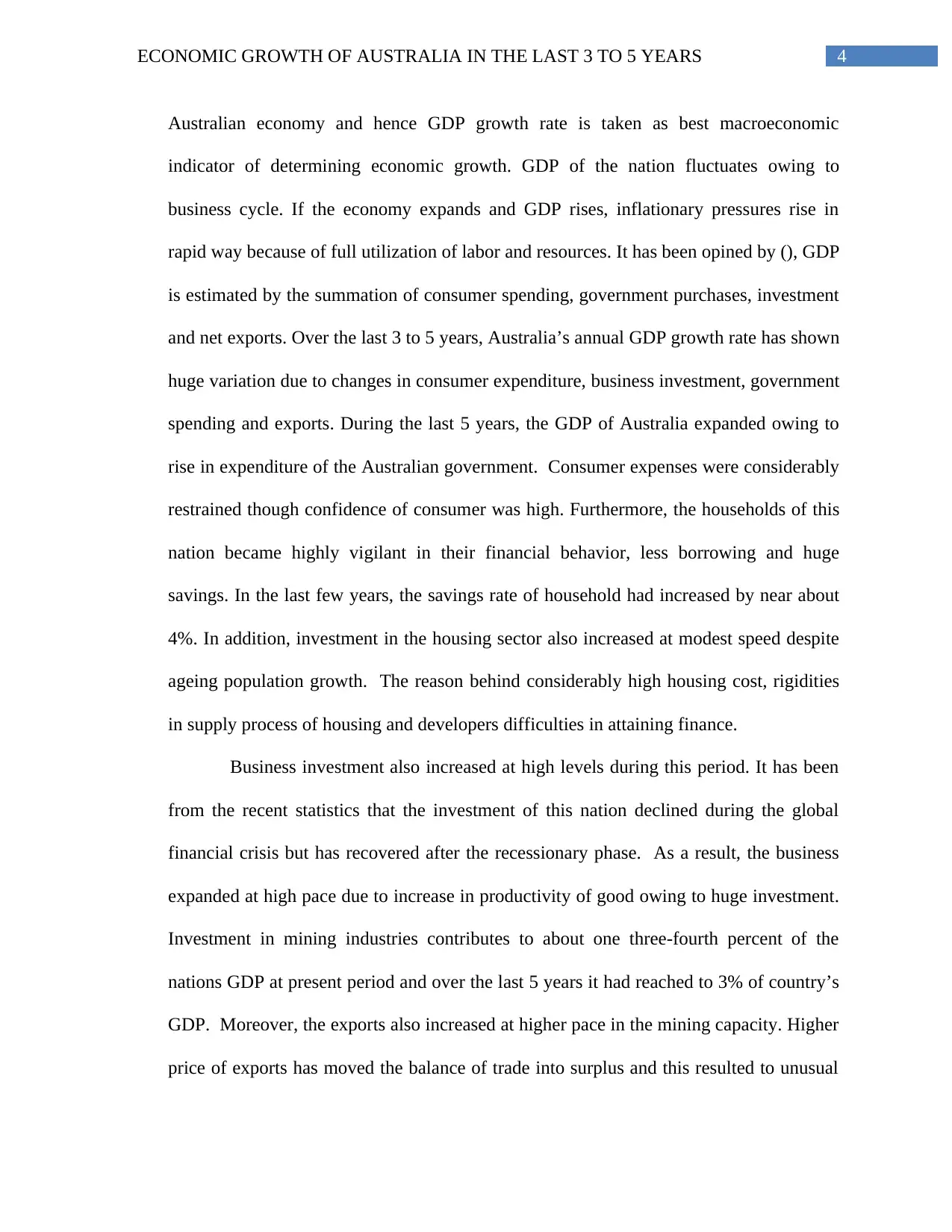
4ECONOMIC GROWTH OF AUSTRALIA IN THE LAST 3 TO 5 YEARS
Australian economy and hence GDP growth rate is taken as best macroeconomic
indicator of determining economic growth. GDP of the nation fluctuates owing to
business cycle. If the economy expands and GDP rises, inflationary pressures rise in
rapid way because of full utilization of labor and resources. It has been opined by (), GDP
is estimated by the summation of consumer spending, government purchases, investment
and net exports. Over the last 3 to 5 years, Australia’s annual GDP growth rate has shown
huge variation due to changes in consumer expenditure, business investment, government
spending and exports. During the last 5 years, the GDP of Australia expanded owing to
rise in expenditure of the Australian government. Consumer expenses were considerably
restrained though confidence of consumer was high. Furthermore, the households of this
nation became highly vigilant in their financial behavior, less borrowing and huge
savings. In the last few years, the savings rate of household had increased by near about
4%. In addition, investment in the housing sector also increased at modest speed despite
ageing population growth. The reason behind considerably high housing cost, rigidities
in supply process of housing and developers difficulties in attaining finance.
Business investment also increased at high levels during this period. It has been
from the recent statistics that the investment of this nation declined during the global
financial crisis but has recovered after the recessionary phase. As a result, the business
expanded at high pace due to increase in productivity of good owing to huge investment.
Investment in mining industries contributes to about one three-fourth percent of the
nations GDP at present period and over the last 5 years it had reached to 3% of country’s
GDP. Moreover, the exports also increased at higher pace in the mining capacity. Higher
price of exports has moved the balance of trade into surplus and this resulted to unusual
Australian economy and hence GDP growth rate is taken as best macroeconomic
indicator of determining economic growth. GDP of the nation fluctuates owing to
business cycle. If the economy expands and GDP rises, inflationary pressures rise in
rapid way because of full utilization of labor and resources. It has been opined by (), GDP
is estimated by the summation of consumer spending, government purchases, investment
and net exports. Over the last 3 to 5 years, Australia’s annual GDP growth rate has shown
huge variation due to changes in consumer expenditure, business investment, government
spending and exports. During the last 5 years, the GDP of Australia expanded owing to
rise in expenditure of the Australian government. Consumer expenses were considerably
restrained though confidence of consumer was high. Furthermore, the households of this
nation became highly vigilant in their financial behavior, less borrowing and huge
savings. In the last few years, the savings rate of household had increased by near about
4%. In addition, investment in the housing sector also increased at modest speed despite
ageing population growth. The reason behind considerably high housing cost, rigidities
in supply process of housing and developers difficulties in attaining finance.
Business investment also increased at high levels during this period. It has been
from the recent statistics that the investment of this nation declined during the global
financial crisis but has recovered after the recessionary phase. As a result, the business
expanded at high pace due to increase in productivity of good owing to huge investment.
Investment in mining industries contributes to about one three-fourth percent of the
nations GDP at present period and over the last 5 years it had reached to 3% of country’s
GDP. Moreover, the exports also increased at higher pace in the mining capacity. Higher
price of exports has moved the balance of trade into surplus and this resulted to unusual
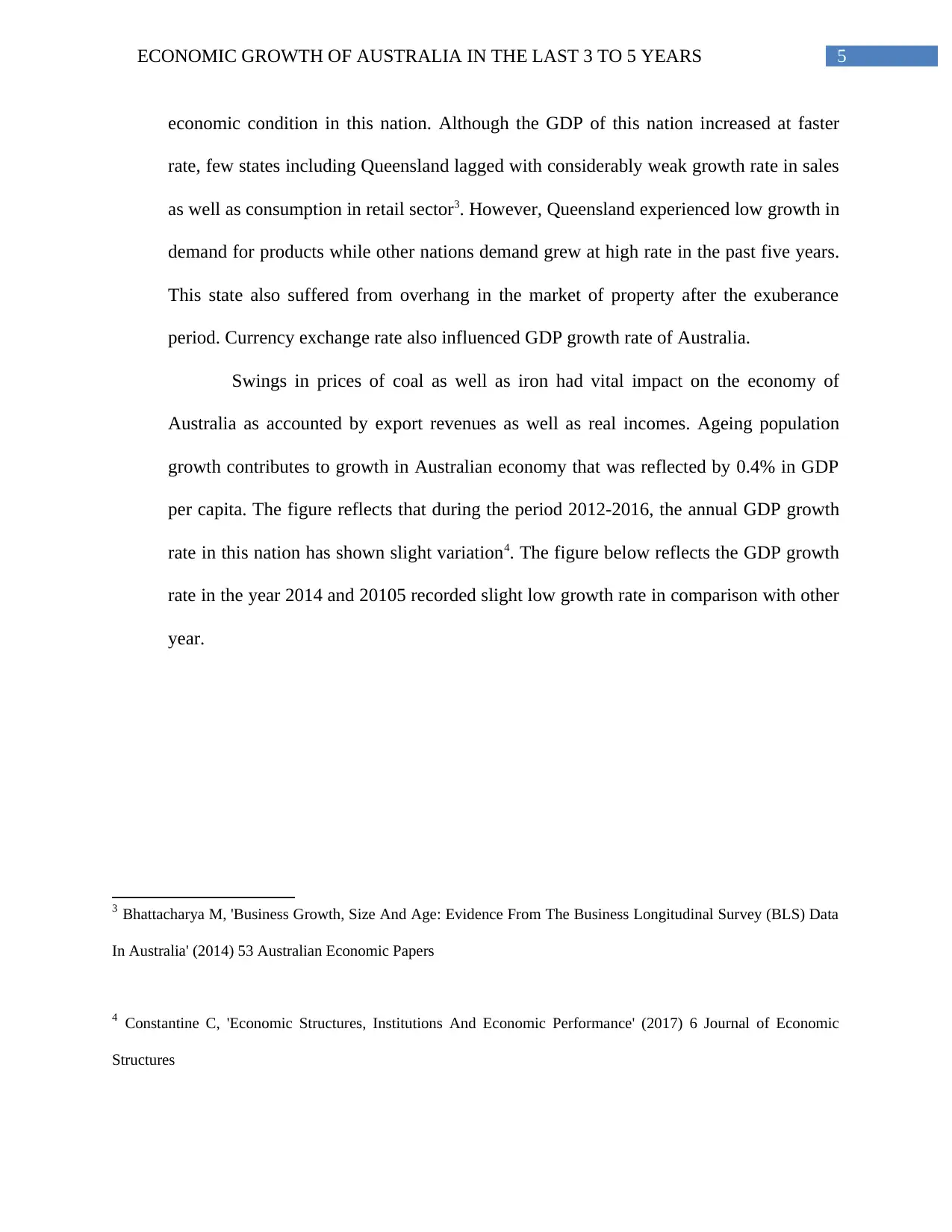
5ECONOMIC GROWTH OF AUSTRALIA IN THE LAST 3 TO 5 YEARS
economic condition in this nation. Although the GDP of this nation increased at faster
rate, few states including Queensland lagged with considerably weak growth rate in sales
as well as consumption in retail sector3. However, Queensland experienced low growth in
demand for products while other nations demand grew at high rate in the past five years.
This state also suffered from overhang in the market of property after the exuberance
period. Currency exchange rate also influenced GDP growth rate of Australia.
Swings in prices of coal as well as iron had vital impact on the economy of
Australia as accounted by export revenues as well as real incomes. Ageing population
growth contributes to growth in Australian economy that was reflected by 0.4% in GDP
per capita. The figure reflects that during the period 2012-2016, the annual GDP growth
rate in this nation has shown slight variation4. The figure below reflects the GDP growth
rate in the year 2014 and 20105 recorded slight low growth rate in comparison with other
year.
3 Bhattacharya M, 'Business Growth, Size And Age: Evidence From The Business Longitudinal Survey (BLS) Data
In Australia' (2014) 53 Australian Economic Papers
4 Constantine C, 'Economic Structures, Institutions And Economic Performance' (2017) 6 Journal of Economic
Structures
economic condition in this nation. Although the GDP of this nation increased at faster
rate, few states including Queensland lagged with considerably weak growth rate in sales
as well as consumption in retail sector3. However, Queensland experienced low growth in
demand for products while other nations demand grew at high rate in the past five years.
This state also suffered from overhang in the market of property after the exuberance
period. Currency exchange rate also influenced GDP growth rate of Australia.
Swings in prices of coal as well as iron had vital impact on the economy of
Australia as accounted by export revenues as well as real incomes. Ageing population
growth contributes to growth in Australian economy that was reflected by 0.4% in GDP
per capita. The figure reflects that during the period 2012-2016, the annual GDP growth
rate in this nation has shown slight variation4. The figure below reflects the GDP growth
rate in the year 2014 and 20105 recorded slight low growth rate in comparison with other
year.
3 Bhattacharya M, 'Business Growth, Size And Age: Evidence From The Business Longitudinal Survey (BLS) Data
In Australia' (2014) 53 Australian Economic Papers
4 Constantine C, 'Economic Structures, Institutions And Economic Performance' (2017) 6 Journal of Economic
Structures
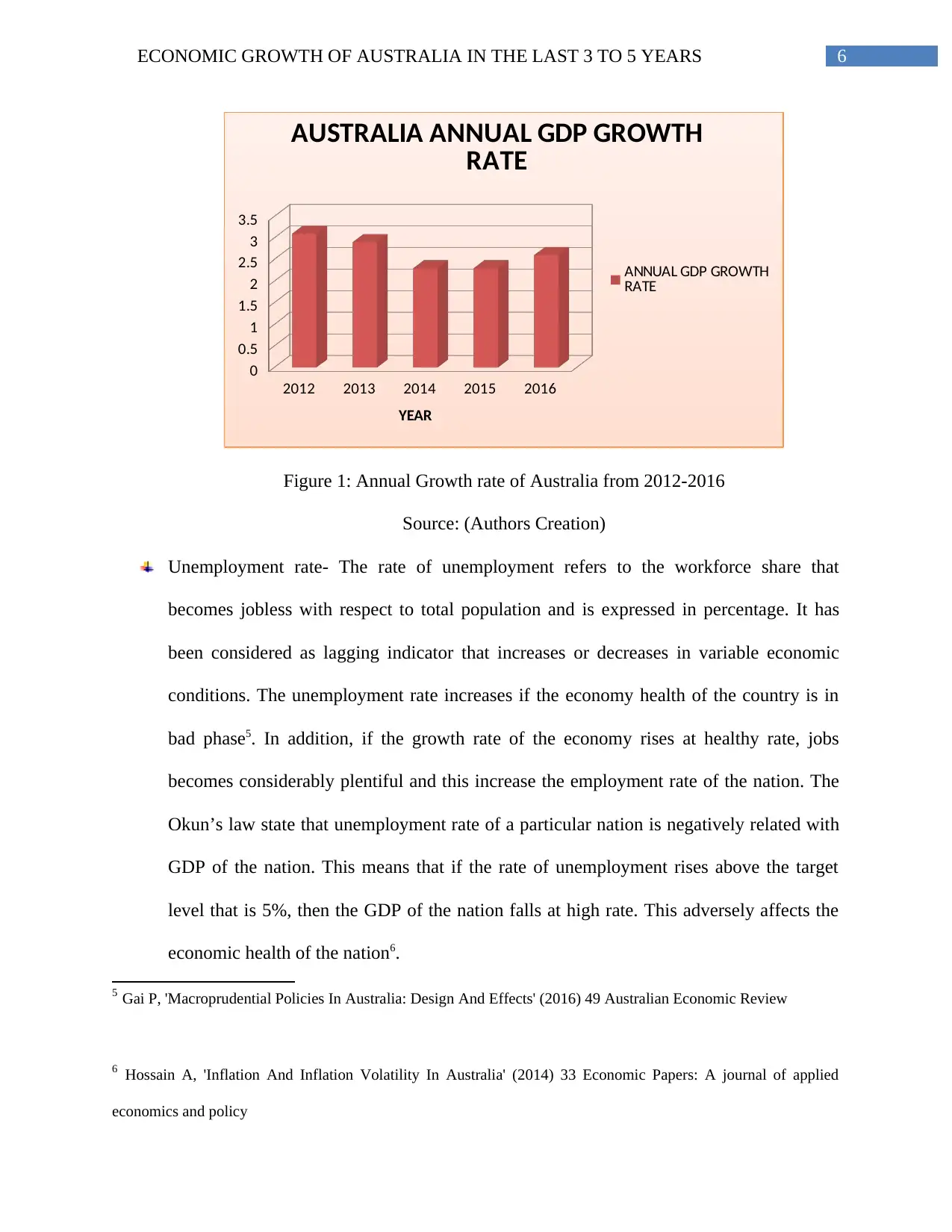
6ECONOMIC GROWTH OF AUSTRALIA IN THE LAST 3 TO 5 YEARS
2012 2013 2014 2015 2016
0
0.5
1
1.5
2
2.5
3
3.5
AUSTRALIA ANNUAL GDP GROWTH
RATE
ANNUAL GDP GROWTH
RATE
YEAR
Figure 1: Annual Growth rate of Australia from 2012-2016
Source: (Authors Creation)
Unemployment rate- The rate of unemployment refers to the workforce share that
becomes jobless with respect to total population and is expressed in percentage. It has
been considered as lagging indicator that increases or decreases in variable economic
conditions. The unemployment rate increases if the economy health of the country is in
bad phase5. In addition, if the growth rate of the economy rises at healthy rate, jobs
becomes considerably plentiful and this increase the employment rate of the nation. The
Okun’s law state that unemployment rate of a particular nation is negatively related with
GDP of the nation. This means that if the rate of unemployment rises above the target
level that is 5%, then the GDP of the nation falls at high rate. This adversely affects the
economic health of the nation6.
5 Gai P, 'Macroprudential Policies In Australia: Design And Effects' (2016) 49 Australian Economic Review
6 Hossain A, 'Inflation And Inflation Volatility In Australia' (2014) 33 Economic Papers: A journal of applied
economics and policy
2012 2013 2014 2015 2016
0
0.5
1
1.5
2
2.5
3
3.5
AUSTRALIA ANNUAL GDP GROWTH
RATE
ANNUAL GDP GROWTH
RATE
YEAR
Figure 1: Annual Growth rate of Australia from 2012-2016
Source: (Authors Creation)
Unemployment rate- The rate of unemployment refers to the workforce share that
becomes jobless with respect to total population and is expressed in percentage. It has
been considered as lagging indicator that increases or decreases in variable economic
conditions. The unemployment rate increases if the economy health of the country is in
bad phase5. In addition, if the growth rate of the economy rises at healthy rate, jobs
becomes considerably plentiful and this increase the employment rate of the nation. The
Okun’s law state that unemployment rate of a particular nation is negatively related with
GDP of the nation. This means that if the rate of unemployment rises above the target
level that is 5%, then the GDP of the nation falls at high rate. This adversely affects the
economic health of the nation6.
5 Gai P, 'Macroprudential Policies In Australia: Design And Effects' (2016) 49 Australian Economic Review
6 Hossain A, 'Inflation And Inflation Volatility In Australia' (2014) 33 Economic Papers: A journal of applied
economics and policy
Paraphrase This Document
Need a fresh take? Get an instant paraphrase of this document with our AI Paraphraser
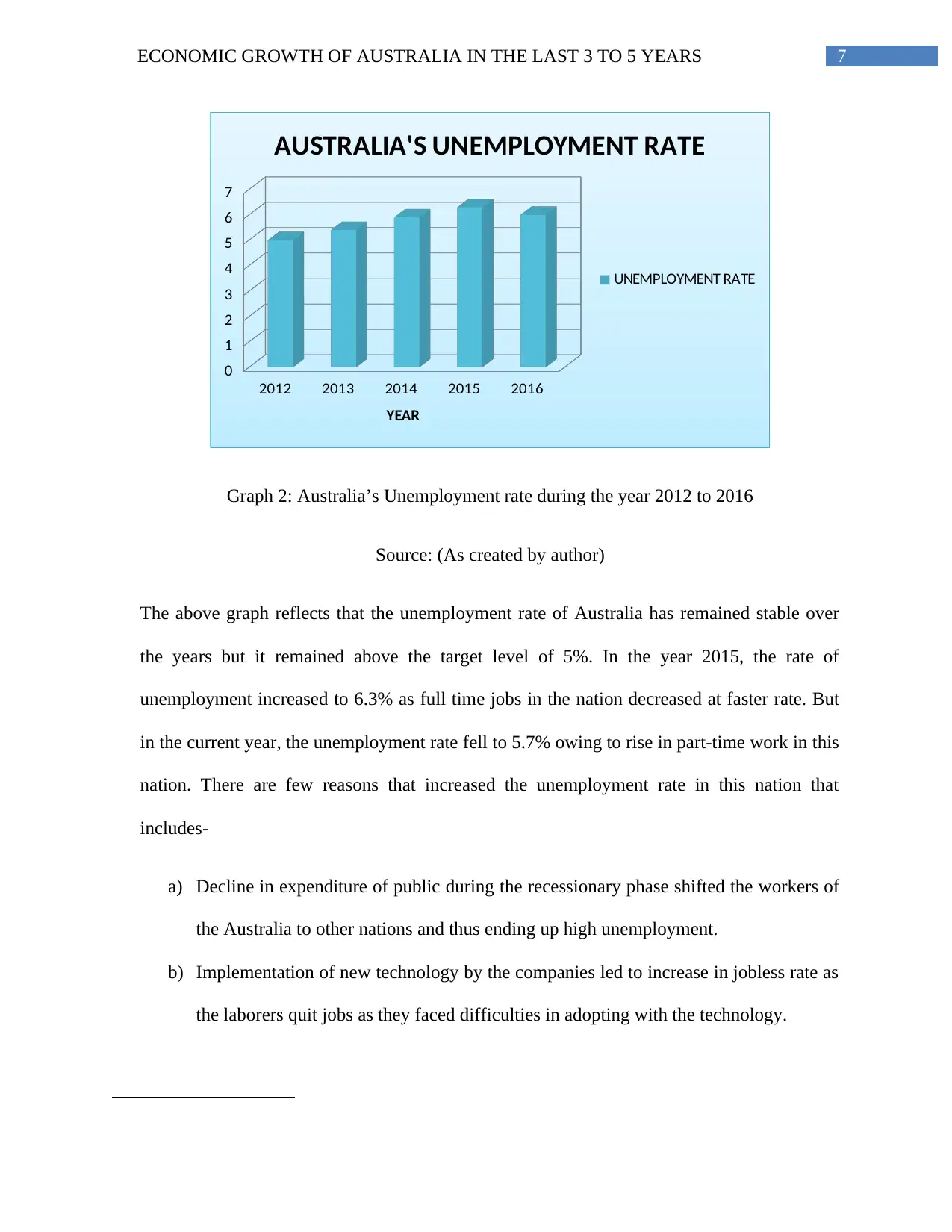
7ECONOMIC GROWTH OF AUSTRALIA IN THE LAST 3 TO 5 YEARS
2012 2013 2014 2015 2016
0
1
2
3
4
5
6
7
AUSTRALIA'S UNEMPLOYMENT RATE
UNEMPLOYMENT RATE
YEAR
Graph 2: Australia’s Unemployment rate during the year 2012 to 2016
Source: (As created by author)
The above graph reflects that the unemployment rate of Australia has remained stable over
the years but it remained above the target level of 5%. In the year 2015, the rate of
unemployment increased to 6.3% as full time jobs in the nation decreased at faster rate. But
in the current year, the unemployment rate fell to 5.7% owing to rise in part-time work in this
nation. There are few reasons that increased the unemployment rate in this nation that
includes-
a) Decline in expenditure of public during the recessionary phase shifted the workers of
the Australia to other nations and thus ending up high unemployment.
b) Implementation of new technology by the companies led to increase in jobless rate as
the laborers quit jobs as they faced difficulties in adopting with the technology.
2012 2013 2014 2015 2016
0
1
2
3
4
5
6
7
AUSTRALIA'S UNEMPLOYMENT RATE
UNEMPLOYMENT RATE
YEAR
Graph 2: Australia’s Unemployment rate during the year 2012 to 2016
Source: (As created by author)
The above graph reflects that the unemployment rate of Australia has remained stable over
the years but it remained above the target level of 5%. In the year 2015, the rate of
unemployment increased to 6.3% as full time jobs in the nation decreased at faster rate. But
in the current year, the unemployment rate fell to 5.7% owing to rise in part-time work in this
nation. There are few reasons that increased the unemployment rate in this nation that
includes-
a) Decline in expenditure of public during the recessionary phase shifted the workers of
the Australia to other nations and thus ending up high unemployment.
b) Implementation of new technology by the companies led to increase in jobless rate as
the laborers quit jobs as they faced difficulties in adopting with the technology.

8ECONOMIC GROWTH OF AUSTRALIA IN THE LAST 3 TO 5 YEARS
c) Another reason of unemployment in Australia is the shutdown of industry. This had
made numerous Australians jobless during this period7. For example in South
Australia huge people were jobless as insufficient industry was unable to absorb these
jobless workers. However, it has been noted that the federal government of Australia
could not prepare advanced planning methods to make transition of workforce into
other job.
d) Offshoring is another vital cause of unemployment in this nation. It increased during
the years as other nations offered incentives on tax to other countries in order to shift
the factories there. However, the workers of Australia have adapted to this as many
manufacturing sector adopted this practice for increasing their productivity.
Therefore, the government of Australia must plan proper policies in order to reduce
unemployment rate in the nation. Since 2011, the rise in unemployment had been
concentrated mostly among male laborers who accounts to high employment percentage
in mining as well as other cyclical sectors8. One type of unemployment that mainly arises
in Australia is frictional unemployment. This occurs when one laborer leaves one job and
searches for another job for more than four weeks. Furthermore, structural unemployment
also occurs owing to sustained weakness in demand for labour.
7 Kumar S, 'Offshoring And Trade Balance In Developed And Emerging Economies' (2013) 17 Review of
Development Economics
8 Lind D, Marchal W and Wathen S, Statistical Techniques In Business & Economics
c) Another reason of unemployment in Australia is the shutdown of industry. This had
made numerous Australians jobless during this period7. For example in South
Australia huge people were jobless as insufficient industry was unable to absorb these
jobless workers. However, it has been noted that the federal government of Australia
could not prepare advanced planning methods to make transition of workforce into
other job.
d) Offshoring is another vital cause of unemployment in this nation. It increased during
the years as other nations offered incentives on tax to other countries in order to shift
the factories there. However, the workers of Australia have adapted to this as many
manufacturing sector adopted this practice for increasing their productivity.
Therefore, the government of Australia must plan proper policies in order to reduce
unemployment rate in the nation. Since 2011, the rise in unemployment had been
concentrated mostly among male laborers who accounts to high employment percentage
in mining as well as other cyclical sectors8. One type of unemployment that mainly arises
in Australia is frictional unemployment. This occurs when one laborer leaves one job and
searches for another job for more than four weeks. Furthermore, structural unemployment
also occurs owing to sustained weakness in demand for labour.
7 Kumar S, 'Offshoring And Trade Balance In Developed And Emerging Economies' (2013) 17 Review of
Development Economics
8 Lind D, Marchal W and Wathen S, Statistical Techniques In Business & Economics

9ECONOMIC GROWTH OF AUSTRALIA IN THE LAST 3 TO 5 YEARS
Inflation rate- Inflation rate refers to the rate at which the price level of products as well
as services increases considerably in a nation over a specific time period9. As the price
level rises for the products, each currency unit purchases less commodities and this
outcomes in decrease in purchasing power in terms of each currency unit. One index that
helps the economy in measuring inflation rate is Consumer price index (CPI). Australia
usually measures their inflation rate with the help of consumer price index. Inflation
influences the nation both positively and negatively. The adverse impact of inflation
includes rise in opportunity cost, uncertainty in rate of inflation that might discourage
investment as well as savings. On the other hand, the positive effects involve declining
real burden of people as well as private debt by maintaining nominal rate of interest
above zero. This facilitates the central bank of the nation in adjusting interest rate for
stabilizing the economy by reducing unemployment rate owing to nominal wage
inflexibility. Economist believes that hyperinflation generally occurs due to excessive
growth in supply of money within the country10. Low rate of inflation attributes to
variation in real demand for commodities or availabilities of supply of goods during
scarce situations11. Thus, the government of respective nations implements contractionary
9 Ma Y, 'Simpson’S Paradox In GDP And Per Capita GDP Growths' (2015) 49 Empirical Economics
10 Nieminen M and Junttila J, 'Short-Run Dynamics Of The Trade Balance In The Emu-12 Countries' (2016) 84 The
Manchester School
11 Wilkins R, 'Measuring Income Inequality In Australia' (2015) 48 Australian Economic Review
Inflation rate- Inflation rate refers to the rate at which the price level of products as well
as services increases considerably in a nation over a specific time period9. As the price
level rises for the products, each currency unit purchases less commodities and this
outcomes in decrease in purchasing power in terms of each currency unit. One index that
helps the economy in measuring inflation rate is Consumer price index (CPI). Australia
usually measures their inflation rate with the help of consumer price index. Inflation
influences the nation both positively and negatively. The adverse impact of inflation
includes rise in opportunity cost, uncertainty in rate of inflation that might discourage
investment as well as savings. On the other hand, the positive effects involve declining
real burden of people as well as private debt by maintaining nominal rate of interest
above zero. This facilitates the central bank of the nation in adjusting interest rate for
stabilizing the economy by reducing unemployment rate owing to nominal wage
inflexibility. Economist believes that hyperinflation generally occurs due to excessive
growth in supply of money within the country10. Low rate of inflation attributes to
variation in real demand for commodities or availabilities of supply of goods during
scarce situations11. Thus, the government of respective nations implements contractionary
9 Ma Y, 'Simpson’S Paradox In GDP And Per Capita GDP Growths' (2015) 49 Empirical Economics
10 Nieminen M and Junttila J, 'Short-Run Dynamics Of The Trade Balance In The Emu-12 Countries' (2016) 84 The
Manchester School
11 Wilkins R, 'Measuring Income Inequality In Australia' (2015) 48 Australian Economic Review
Secure Best Marks with AI Grader
Need help grading? Try our AI Grader for instant feedback on your assignments.
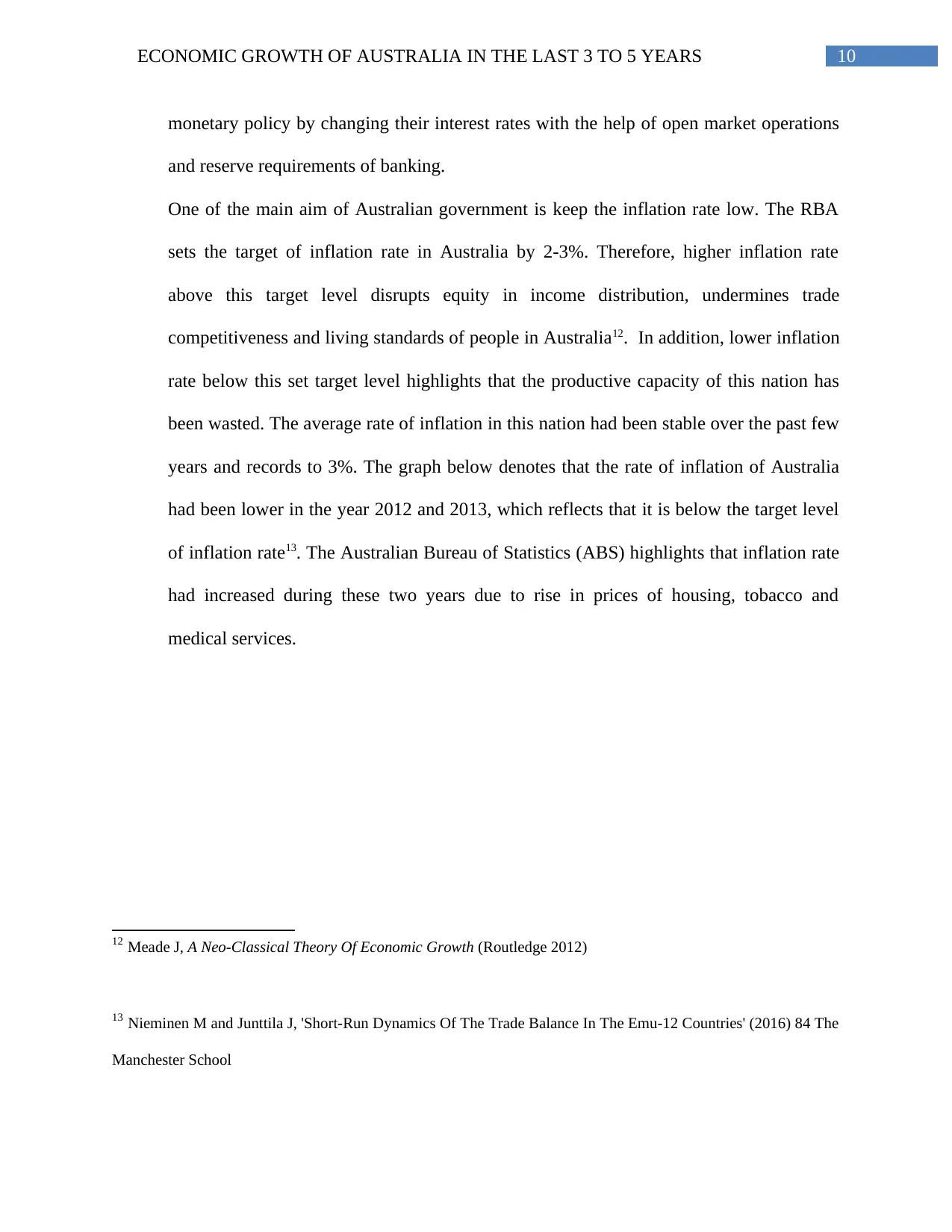
10ECONOMIC GROWTH OF AUSTRALIA IN THE LAST 3 TO 5 YEARS
monetary policy by changing their interest rates with the help of open market operations
and reserve requirements of banking.
One of the main aim of Australian government is keep the inflation rate low. The RBA
sets the target of inflation rate in Australia by 2-3%. Therefore, higher inflation rate
above this target level disrupts equity in income distribution, undermines trade
competitiveness and living standards of people in Australia12. In addition, lower inflation
rate below this set target level highlights that the productive capacity of this nation has
been wasted. The average rate of inflation in this nation had been stable over the past few
years and records to 3%. The graph below denotes that the rate of inflation of Australia
had been lower in the year 2012 and 2013, which reflects that it is below the target level
of inflation rate13. The Australian Bureau of Statistics (ABS) highlights that inflation rate
had increased during these two years due to rise in prices of housing, tobacco and
medical services.
12 Meade J, A Neo-Classical Theory Of Economic Growth (Routledge 2012)
13 Nieminen M and Junttila J, 'Short-Run Dynamics Of The Trade Balance In The Emu-12 Countries' (2016) 84 The
Manchester School
monetary policy by changing their interest rates with the help of open market operations
and reserve requirements of banking.
One of the main aim of Australian government is keep the inflation rate low. The RBA
sets the target of inflation rate in Australia by 2-3%. Therefore, higher inflation rate
above this target level disrupts equity in income distribution, undermines trade
competitiveness and living standards of people in Australia12. In addition, lower inflation
rate below this set target level highlights that the productive capacity of this nation has
been wasted. The average rate of inflation in this nation had been stable over the past few
years and records to 3%. The graph below denotes that the rate of inflation of Australia
had been lower in the year 2012 and 2013, which reflects that it is below the target level
of inflation rate13. The Australian Bureau of Statistics (ABS) highlights that inflation rate
had increased during these two years due to rise in prices of housing, tobacco and
medical services.
12 Meade J, A Neo-Classical Theory Of Economic Growth (Routledge 2012)
13 Nieminen M and Junttila J, 'Short-Run Dynamics Of The Trade Balance In The Emu-12 Countries' (2016) 84 The
Manchester School
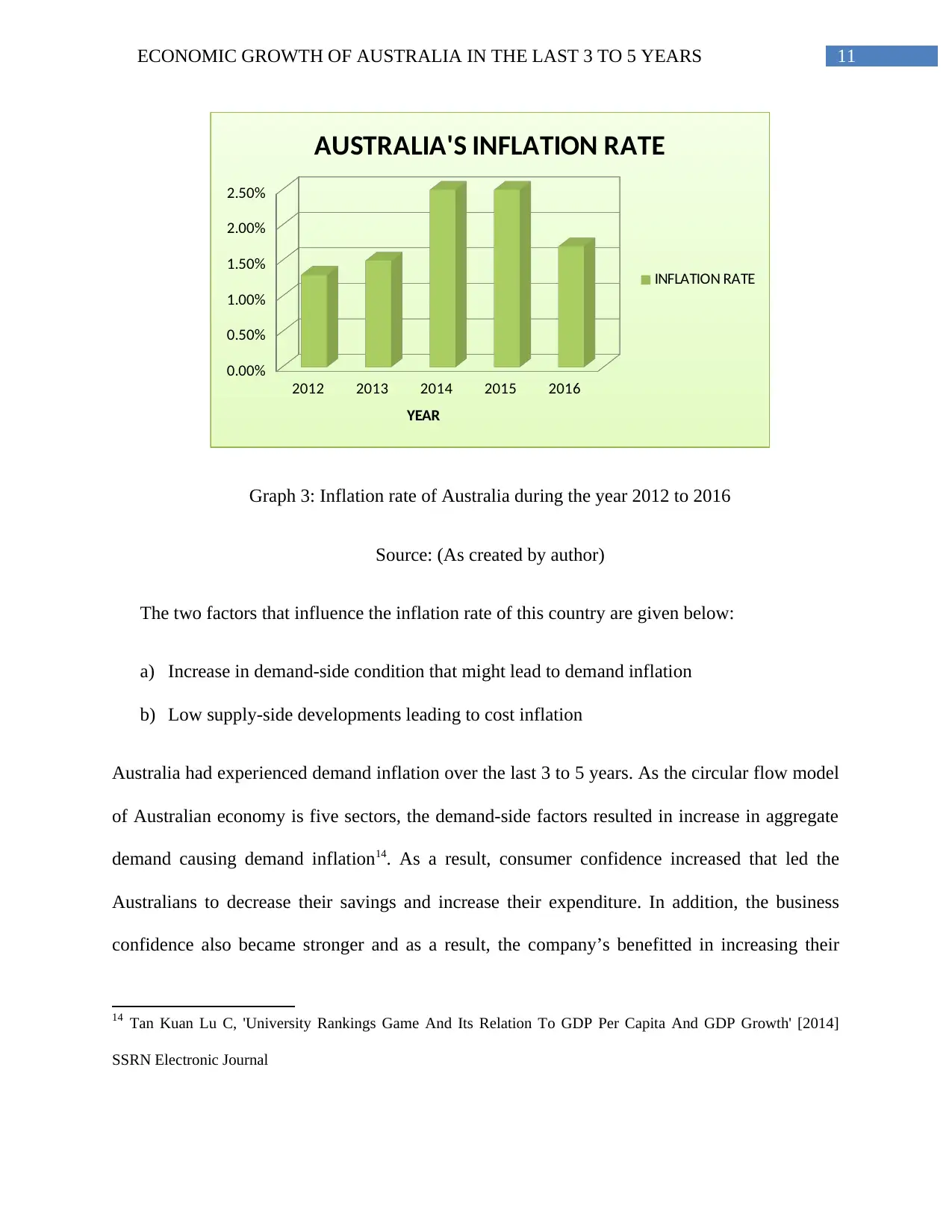
11ECONOMIC GROWTH OF AUSTRALIA IN THE LAST 3 TO 5 YEARS
2012 2013 2014 2015 2016
0.00%
0.50%
1.00%
1.50%
2.00%
2.50%
AUSTRALIA'S INFLATION RATE
INFLATION RATE
YEAR
Graph 3: Inflation rate of Australia during the year 2012 to 2016
Source: (As created by author)
The two factors that influence the inflation rate of this country are given below:
a) Increase in demand-side condition that might lead to demand inflation
b) Low supply-side developments leading to cost inflation
Australia had experienced demand inflation over the last 3 to 5 years. As the circular flow model
of Australian economy is five sectors, the demand-side factors resulted in increase in aggregate
demand causing demand inflation14. As a result, consumer confidence increased that led the
Australians to decrease their savings and increase their expenditure. In addition, the business
confidence also became stronger and as a result, the company’s benefitted in increasing their
14 Tan Kuan Lu C, 'University Rankings Game And Its Relation To GDP Per Capita And GDP Growth' [2014]
SSRN Electronic Journal
2012 2013 2014 2015 2016
0.00%
0.50%
1.00%
1.50%
2.00%
2.50%
AUSTRALIA'S INFLATION RATE
INFLATION RATE
YEAR
Graph 3: Inflation rate of Australia during the year 2012 to 2016
Source: (As created by author)
The two factors that influence the inflation rate of this country are given below:
a) Increase in demand-side condition that might lead to demand inflation
b) Low supply-side developments leading to cost inflation
Australia had experienced demand inflation over the last 3 to 5 years. As the circular flow model
of Australian economy is five sectors, the demand-side factors resulted in increase in aggregate
demand causing demand inflation14. As a result, consumer confidence increased that led the
Australians to decrease their savings and increase their expenditure. In addition, the business
confidence also became stronger and as a result, the company’s benefitted in increasing their
14 Tan Kuan Lu C, 'University Rankings Game And Its Relation To GDP Per Capita And GDP Growth' [2014]
SSRN Electronic Journal
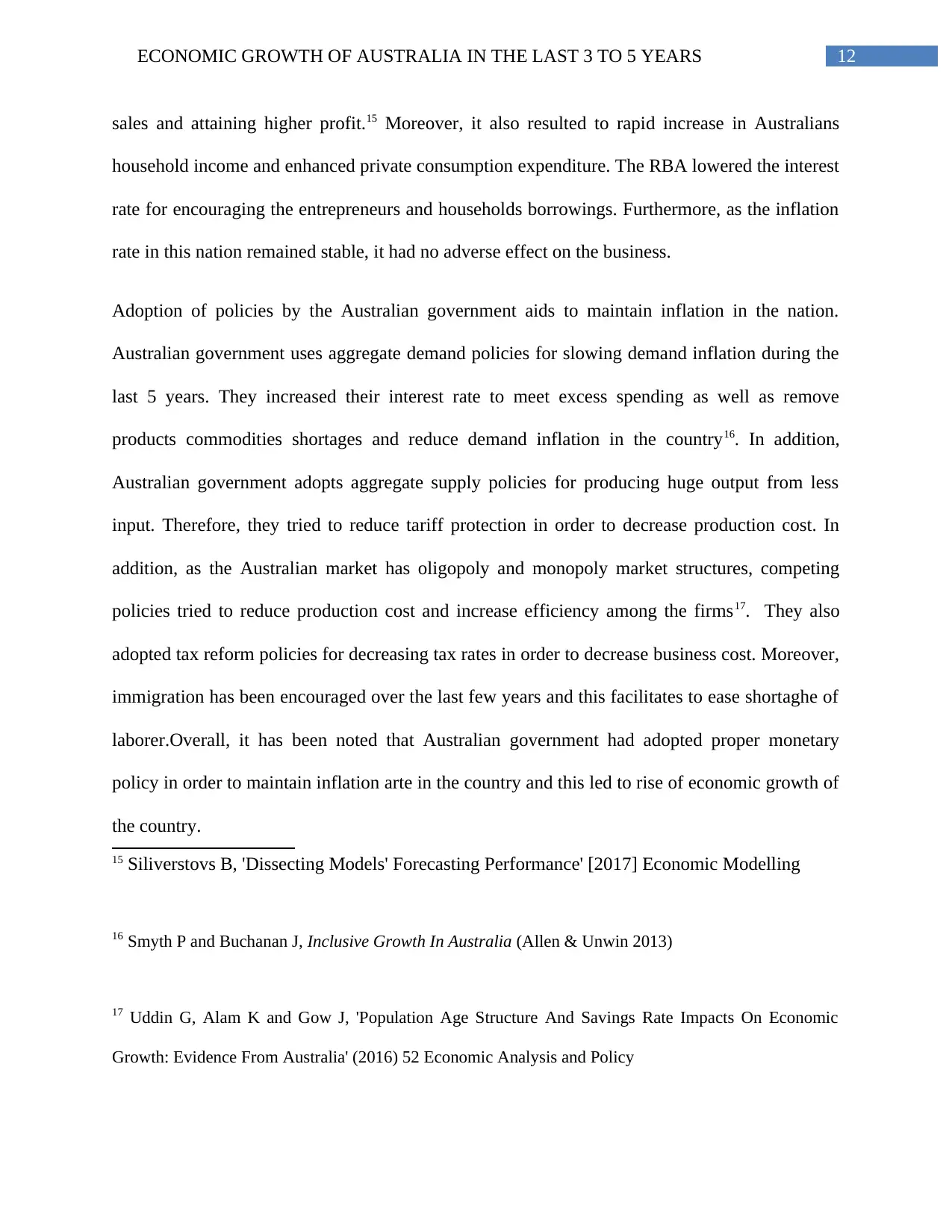
12ECONOMIC GROWTH OF AUSTRALIA IN THE LAST 3 TO 5 YEARS
sales and attaining higher profit.15 Moreover, it also resulted to rapid increase in Australians
household income and enhanced private consumption expenditure. The RBA lowered the interest
rate for encouraging the entrepreneurs and households borrowings. Furthermore, as the inflation
rate in this nation remained stable, it had no adverse effect on the business.
Adoption of policies by the Australian government aids to maintain inflation in the nation.
Australian government uses aggregate demand policies for slowing demand inflation during the
last 5 years. They increased their interest rate to meet excess spending as well as remove
products commodities shortages and reduce demand inflation in the country16. In addition,
Australian government adopts aggregate supply policies for producing huge output from less
input. Therefore, they tried to reduce tariff protection in order to decrease production cost. In
addition, as the Australian market has oligopoly and monopoly market structures, competing
policies tried to reduce production cost and increase efficiency among the firms17. They also
adopted tax reform policies for decreasing tax rates in order to decrease business cost. Moreover,
immigration has been encouraged over the last few years and this facilitates to ease shortaghe of
laborer.Overall, it has been noted that Australian government had adopted proper monetary
policy in order to maintain inflation arte in the country and this led to rise of economic growth of
the country.
15 Siliverstovs B, 'Dissecting Models' Forecasting Performance' [2017] Economic Modelling
16 Smyth P and Buchanan J, Inclusive Growth In Australia (Allen & Unwin 2013)
17 Uddin G, Alam K and Gow J, 'Population Age Structure And Savings Rate Impacts On Economic
Growth: Evidence From Australia' (2016) 52 Economic Analysis and Policy
sales and attaining higher profit.15 Moreover, it also resulted to rapid increase in Australians
household income and enhanced private consumption expenditure. The RBA lowered the interest
rate for encouraging the entrepreneurs and households borrowings. Furthermore, as the inflation
rate in this nation remained stable, it had no adverse effect on the business.
Adoption of policies by the Australian government aids to maintain inflation in the nation.
Australian government uses aggregate demand policies for slowing demand inflation during the
last 5 years. They increased their interest rate to meet excess spending as well as remove
products commodities shortages and reduce demand inflation in the country16. In addition,
Australian government adopts aggregate supply policies for producing huge output from less
input. Therefore, they tried to reduce tariff protection in order to decrease production cost. In
addition, as the Australian market has oligopoly and monopoly market structures, competing
policies tried to reduce production cost and increase efficiency among the firms17. They also
adopted tax reform policies for decreasing tax rates in order to decrease business cost. Moreover,
immigration has been encouraged over the last few years and this facilitates to ease shortaghe of
laborer.Overall, it has been noted that Australian government had adopted proper monetary
policy in order to maintain inflation arte in the country and this led to rise of economic growth of
the country.
15 Siliverstovs B, 'Dissecting Models' Forecasting Performance' [2017] Economic Modelling
16 Smyth P and Buchanan J, Inclusive Growth In Australia (Allen & Unwin 2013)
17 Uddin G, Alam K and Gow J, 'Population Age Structure And Savings Rate Impacts On Economic
Growth: Evidence From Australia' (2016) 52 Economic Analysis and Policy
Paraphrase This Document
Need a fresh take? Get an instant paraphrase of this document with our AI Paraphraser
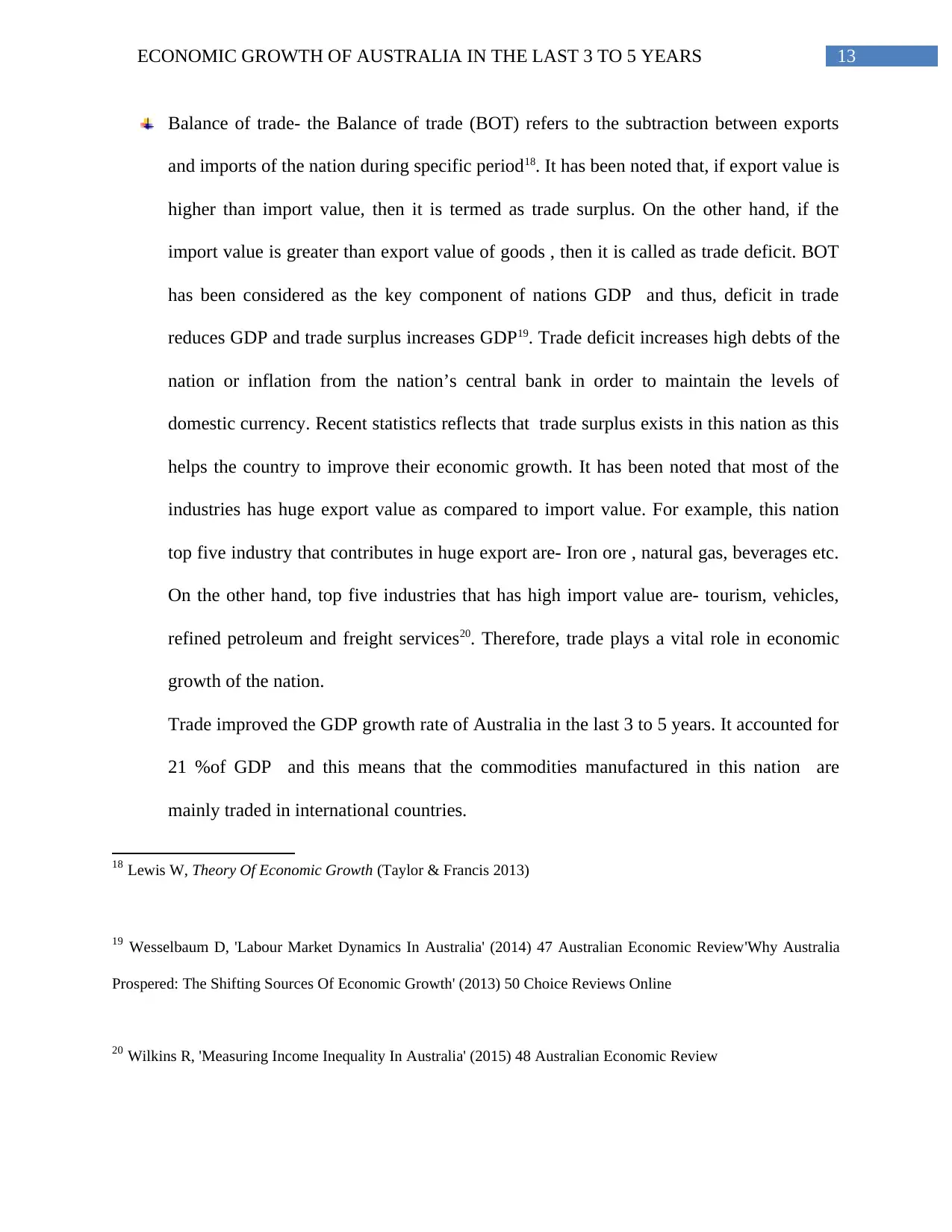
13ECONOMIC GROWTH OF AUSTRALIA IN THE LAST 3 TO 5 YEARS
Balance of trade- the Balance of trade (BOT) refers to the subtraction between exports
and imports of the nation during specific period18. It has been noted that, if export value is
higher than import value, then it is termed as trade surplus. On the other hand, if the
import value is greater than export value of goods , then it is called as trade deficit. BOT
has been considered as the key component of nations GDP and thus, deficit in trade
reduces GDP and trade surplus increases GDP19. Trade deficit increases high debts of the
nation or inflation from the nation’s central bank in order to maintain the levels of
domestic currency. Recent statistics reflects that trade surplus exists in this nation as this
helps the country to improve their economic growth. It has been noted that most of the
industries has huge export value as compared to import value. For example, this nation
top five industry that contributes in huge export are- Iron ore , natural gas, beverages etc.
On the other hand, top five industries that has high import value are- tourism, vehicles,
refined petroleum and freight services20. Therefore, trade plays a vital role in economic
growth of the nation.
Trade improved the GDP growth rate of Australia in the last 3 to 5 years. It accounted for
21 %of GDP and this means that the commodities manufactured in this nation are
mainly traded in international countries.
18 Lewis W, Theory Of Economic Growth (Taylor & Francis 2013)
19 Wesselbaum D, 'Labour Market Dynamics In Australia' (2014) 47 Australian Economic Review'Why Australia
Prospered: The Shifting Sources Of Economic Growth' (2013) 50 Choice Reviews Online
20 Wilkins R, 'Measuring Income Inequality In Australia' (2015) 48 Australian Economic Review
Balance of trade- the Balance of trade (BOT) refers to the subtraction between exports
and imports of the nation during specific period18. It has been noted that, if export value is
higher than import value, then it is termed as trade surplus. On the other hand, if the
import value is greater than export value of goods , then it is called as trade deficit. BOT
has been considered as the key component of nations GDP and thus, deficit in trade
reduces GDP and trade surplus increases GDP19. Trade deficit increases high debts of the
nation or inflation from the nation’s central bank in order to maintain the levels of
domestic currency. Recent statistics reflects that trade surplus exists in this nation as this
helps the country to improve their economic growth. It has been noted that most of the
industries has huge export value as compared to import value. For example, this nation
top five industry that contributes in huge export are- Iron ore , natural gas, beverages etc.
On the other hand, top five industries that has high import value are- tourism, vehicles,
refined petroleum and freight services20. Therefore, trade plays a vital role in economic
growth of the nation.
Trade improved the GDP growth rate of Australia in the last 3 to 5 years. It accounted for
21 %of GDP and this means that the commodities manufactured in this nation are
mainly traded in international countries.
18 Lewis W, Theory Of Economic Growth (Taylor & Francis 2013)
19 Wesselbaum D, 'Labour Market Dynamics In Australia' (2014) 47 Australian Economic Review'Why Australia
Prospered: The Shifting Sources Of Economic Growth' (2013) 50 Choice Reviews Online
20 Wilkins R, 'Measuring Income Inequality In Australia' (2015) 48 Australian Economic Review
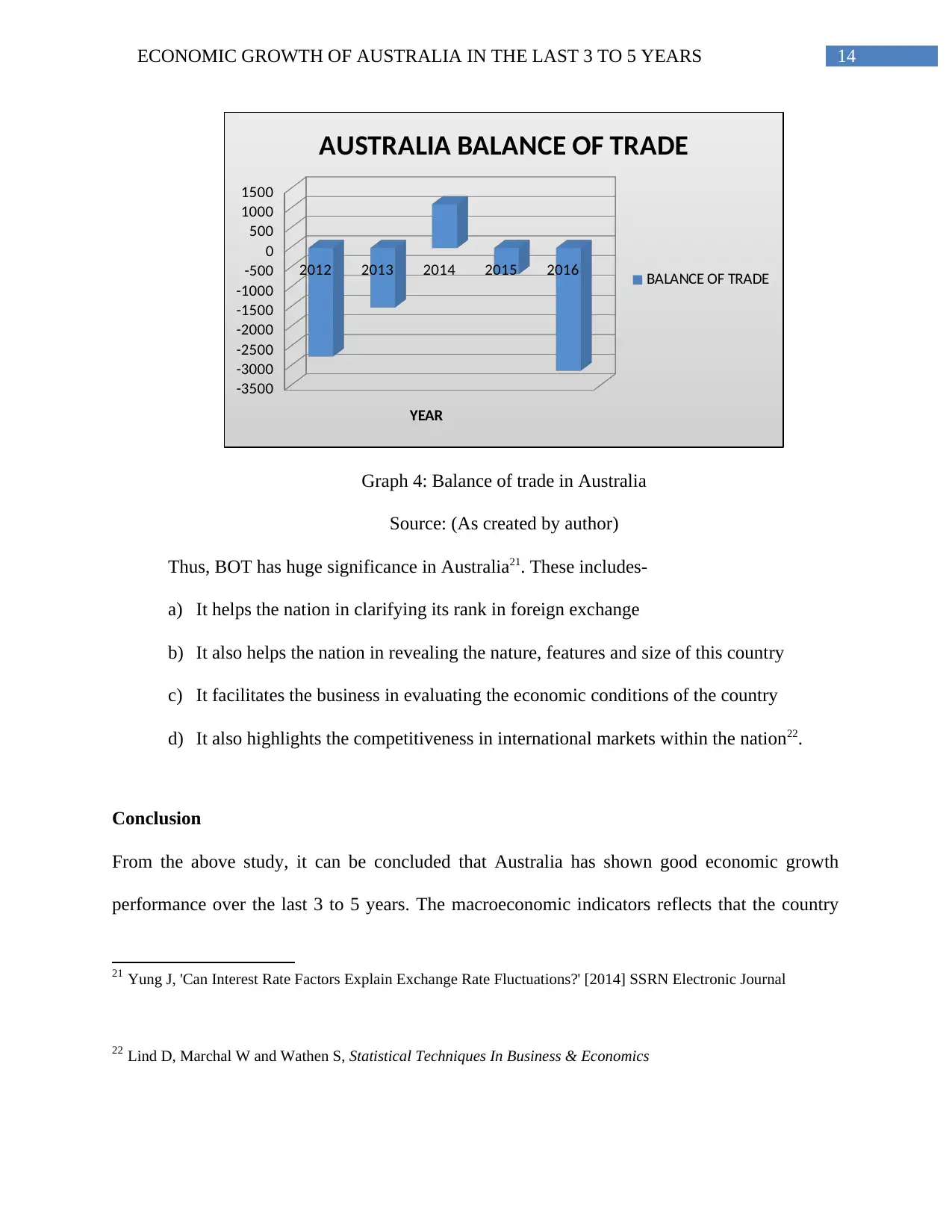
14ECONOMIC GROWTH OF AUSTRALIA IN THE LAST 3 TO 5 YEARS
2012 2013 2014 2015 2016
-3500
-3000
-2500
-2000
-1500
-1000
-500
0
500
1000
1500
AUSTRALIA BALANCE OF TRADE
BALANCE OF TRADE
YEAR
Graph 4: Balance of trade in Australia
Source: (As created by author)
Thus, BOT has huge significance in Australia21. These includes-
a) It helps the nation in clarifying its rank in foreign exchange
b) It also helps the nation in revealing the nature, features and size of this country
c) It facilitates the business in evaluating the economic conditions of the country
d) It also highlights the competitiveness in international markets within the nation22.
Conclusion
From the above study, it can be concluded that Australia has shown good economic growth
performance over the last 3 to 5 years. The macroeconomic indicators reflects that the country
21 Yung J, 'Can Interest Rate Factors Explain Exchange Rate Fluctuations?' [2014] SSRN Electronic Journal
22 Lind D, Marchal W and Wathen S, Statistical Techniques In Business & Economics
2012 2013 2014 2015 2016
-3500
-3000
-2500
-2000
-1500
-1000
-500
0
500
1000
1500
AUSTRALIA BALANCE OF TRADE
BALANCE OF TRADE
YEAR
Graph 4: Balance of trade in Australia
Source: (As created by author)
Thus, BOT has huge significance in Australia21. These includes-
a) It helps the nation in clarifying its rank in foreign exchange
b) It also helps the nation in revealing the nature, features and size of this country
c) It facilitates the business in evaluating the economic conditions of the country
d) It also highlights the competitiveness in international markets within the nation22.
Conclusion
From the above study, it can be concluded that Australia has shown good economic growth
performance over the last 3 to 5 years. The macroeconomic indicators reflects that the country
21 Yung J, 'Can Interest Rate Factors Explain Exchange Rate Fluctuations?' [2014] SSRN Electronic Journal
22 Lind D, Marchal W and Wathen S, Statistical Techniques In Business & Economics

15ECONOMIC GROWTH OF AUSTRALIA IN THE LAST 3 TO 5 YEARS
has maintained stable economic growth rate even though there was huge growth variation across
various industries existing in the nation. This benefits of economic growth had spread widely
among the states and across distribution of peoples income. Australian government also plays
vital role in improving economic conditions of the country. The policies adopted by the
government helps the Australian economy to recover from recessionary phase. Even the change
in tax structure contributed to expansion of business in this nation. Contractionary monetary
policy adopted by RBA also helped the economy in maintaining stable inflation in the nation. At
present, the country is now operating to high capacity and this improves the nations productivity
and sustains economic growth.
has maintained stable economic growth rate even though there was huge growth variation across
various industries existing in the nation. This benefits of economic growth had spread widely
among the states and across distribution of peoples income. Australian government also plays
vital role in improving economic conditions of the country. The policies adopted by the
government helps the Australian economy to recover from recessionary phase. Even the change
in tax structure contributed to expansion of business in this nation. Contractionary monetary
policy adopted by RBA also helped the economy in maintaining stable inflation in the nation. At
present, the country is now operating to high capacity and this improves the nations productivity
and sustains economic growth.
Secure Best Marks with AI Grader
Need help grading? Try our AI Grader for instant feedback on your assignments.

16ECONOMIC GROWTH OF AUSTRALIA IN THE LAST 3 TO 5 YEARS
References
Anderson K, 'Sectoral Trends And Shocks In Australia's Economic Growth' (2017) 57 Australian
Economic History Review
Bhattacharya M, 'Business Growth, Size And Age: Evidence From The Business Longitudinal
Survey (BLS) Data In Australia' (2014) 53 Australian Economic Papers
Ceil C, 'Water Scarcity And Economic Growth Connection In Australia' [2012] SSRN Electronic
Journal
Constantine C, 'Economic Structures, Institutions And Economic Performance' (2017) 6 Journal
of Economic Structures
Gai P, 'Macroprudential Policies In Australia: Design And Effects' (2016) 49 Australian
Economic Review
Hossain A, 'Inflation And Inflation Volatility In Australia' (2014) 33 Economic Papers: A journal
of applied economics and policy
Johnson M, 'Book Review: Paul Smyth And John Buchanan (Eds), Inclusive Growth In
Australia: Social Policy As Economic Investmentsmythpaulbuchananjohn (Eds) Inclusive
Growth In Australia: Social Policy As Economic Investment. Allen & Unwin: Sydney, NSW,
Australia, 2013; 290 Pp.: 9781743311301 (Pbk).' (2014) 25 The Economic and Labour Relations
Review
KNEDLIK T and VON SCHWEINITZ G, 'Macroeconomic Imbalances As Indicators For Debt
Crises In Europe*' (2012) 50 JCMS: Journal of Common Market Studies
References
Anderson K, 'Sectoral Trends And Shocks In Australia's Economic Growth' (2017) 57 Australian
Economic History Review
Bhattacharya M, 'Business Growth, Size And Age: Evidence From The Business Longitudinal
Survey (BLS) Data In Australia' (2014) 53 Australian Economic Papers
Ceil C, 'Water Scarcity And Economic Growth Connection In Australia' [2012] SSRN Electronic
Journal
Constantine C, 'Economic Structures, Institutions And Economic Performance' (2017) 6 Journal
of Economic Structures
Gai P, 'Macroprudential Policies In Australia: Design And Effects' (2016) 49 Australian
Economic Review
Hossain A, 'Inflation And Inflation Volatility In Australia' (2014) 33 Economic Papers: A journal
of applied economics and policy
Johnson M, 'Book Review: Paul Smyth And John Buchanan (Eds), Inclusive Growth In
Australia: Social Policy As Economic Investmentsmythpaulbuchananjohn (Eds) Inclusive
Growth In Australia: Social Policy As Economic Investment. Allen & Unwin: Sydney, NSW,
Australia, 2013; 290 Pp.: 9781743311301 (Pbk).' (2014) 25 The Economic and Labour Relations
Review
KNEDLIK T and VON SCHWEINITZ G, 'Macroeconomic Imbalances As Indicators For Debt
Crises In Europe*' (2012) 50 JCMS: Journal of Common Market Studies
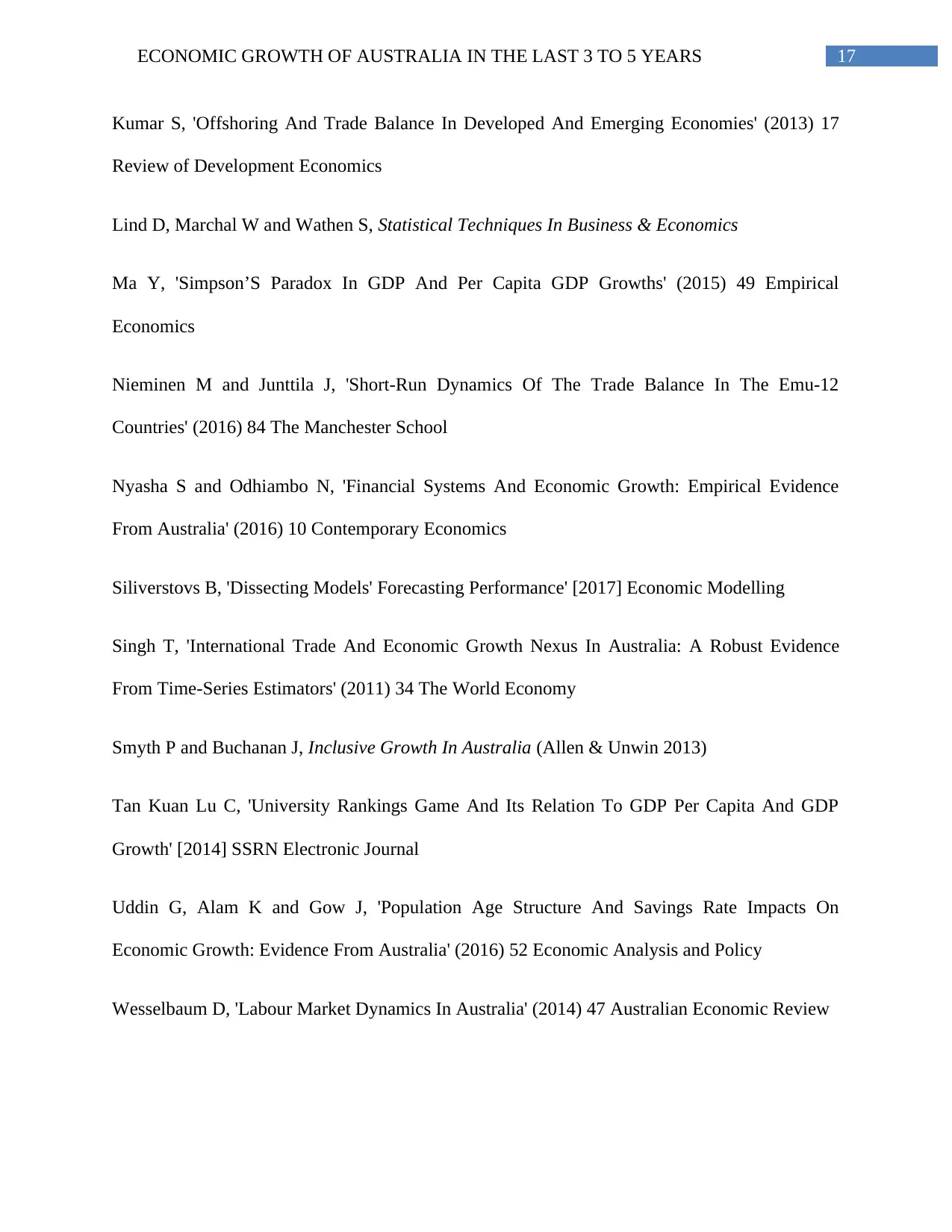
17ECONOMIC GROWTH OF AUSTRALIA IN THE LAST 3 TO 5 YEARS
Kumar S, 'Offshoring And Trade Balance In Developed And Emerging Economies' (2013) 17
Review of Development Economics
Lind D, Marchal W and Wathen S, Statistical Techniques In Business & Economics
Ma Y, 'Simpson’S Paradox In GDP And Per Capita GDP Growths' (2015) 49 Empirical
Economics
Nieminen M and Junttila J, 'Short-Run Dynamics Of The Trade Balance In The Emu-12
Countries' (2016) 84 The Manchester School
Nyasha S and Odhiambo N, 'Financial Systems And Economic Growth: Empirical Evidence
From Australia' (2016) 10 Contemporary Economics
Siliverstovs B, 'Dissecting Models' Forecasting Performance' [2017] Economic Modelling
Singh T, 'International Trade And Economic Growth Nexus In Australia: A Robust Evidence
From Time-Series Estimators' (2011) 34 The World Economy
Smyth P and Buchanan J, Inclusive Growth In Australia (Allen & Unwin 2013)
Tan Kuan Lu C, 'University Rankings Game And Its Relation To GDP Per Capita And GDP
Growth' [2014] SSRN Electronic Journal
Uddin G, Alam K and Gow J, 'Population Age Structure And Savings Rate Impacts On
Economic Growth: Evidence From Australia' (2016) 52 Economic Analysis and Policy
Wesselbaum D, 'Labour Market Dynamics In Australia' (2014) 47 Australian Economic Review
Kumar S, 'Offshoring And Trade Balance In Developed And Emerging Economies' (2013) 17
Review of Development Economics
Lind D, Marchal W and Wathen S, Statistical Techniques In Business & Economics
Ma Y, 'Simpson’S Paradox In GDP And Per Capita GDP Growths' (2015) 49 Empirical
Economics
Nieminen M and Junttila J, 'Short-Run Dynamics Of The Trade Balance In The Emu-12
Countries' (2016) 84 The Manchester School
Nyasha S and Odhiambo N, 'Financial Systems And Economic Growth: Empirical Evidence
From Australia' (2016) 10 Contemporary Economics
Siliverstovs B, 'Dissecting Models' Forecasting Performance' [2017] Economic Modelling
Singh T, 'International Trade And Economic Growth Nexus In Australia: A Robust Evidence
From Time-Series Estimators' (2011) 34 The World Economy
Smyth P and Buchanan J, Inclusive Growth In Australia (Allen & Unwin 2013)
Tan Kuan Lu C, 'University Rankings Game And Its Relation To GDP Per Capita And GDP
Growth' [2014] SSRN Electronic Journal
Uddin G, Alam K and Gow J, 'Population Age Structure And Savings Rate Impacts On
Economic Growth: Evidence From Australia' (2016) 52 Economic Analysis and Policy
Wesselbaum D, 'Labour Market Dynamics In Australia' (2014) 47 Australian Economic Review
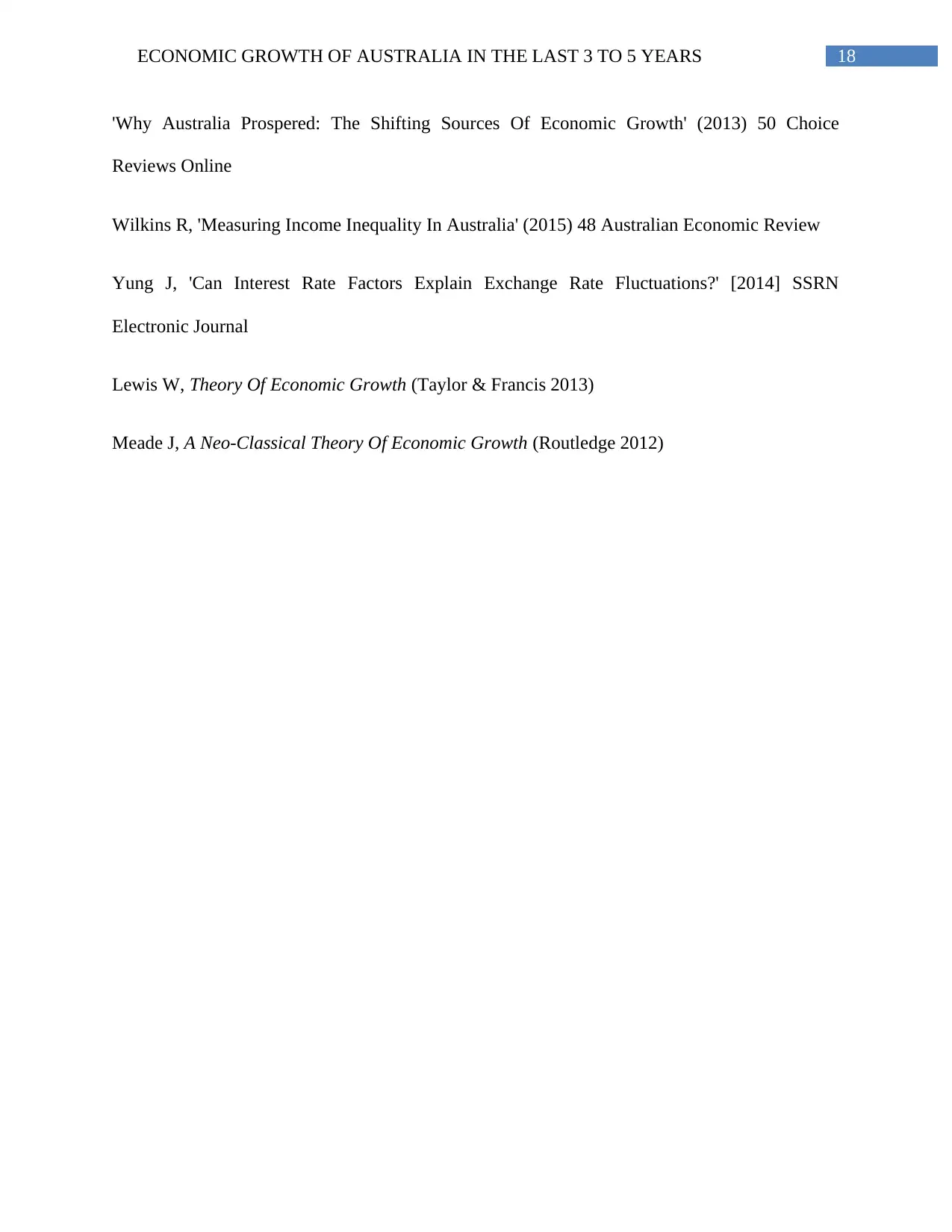
18ECONOMIC GROWTH OF AUSTRALIA IN THE LAST 3 TO 5 YEARS
'Why Australia Prospered: The Shifting Sources Of Economic Growth' (2013) 50 Choice
Reviews Online
Wilkins R, 'Measuring Income Inequality In Australia' (2015) 48 Australian Economic Review
Yung J, 'Can Interest Rate Factors Explain Exchange Rate Fluctuations?' [2014] SSRN
Electronic Journal
Lewis W, Theory Of Economic Growth (Taylor & Francis 2013)
Meade J, A Neo-Classical Theory Of Economic Growth (Routledge 2012)
'Why Australia Prospered: The Shifting Sources Of Economic Growth' (2013) 50 Choice
Reviews Online
Wilkins R, 'Measuring Income Inequality In Australia' (2015) 48 Australian Economic Review
Yung J, 'Can Interest Rate Factors Explain Exchange Rate Fluctuations?' [2014] SSRN
Electronic Journal
Lewis W, Theory Of Economic Growth (Taylor & Francis 2013)
Meade J, A Neo-Classical Theory Of Economic Growth (Routledge 2012)
1 out of 19
Related Documents
Your All-in-One AI-Powered Toolkit for Academic Success.
+13062052269
info@desklib.com
Available 24*7 on WhatsApp / Email
![[object Object]](/_next/static/media/star-bottom.7253800d.svg)
Unlock your academic potential
© 2024 | Zucol Services PVT LTD | All rights reserved.





